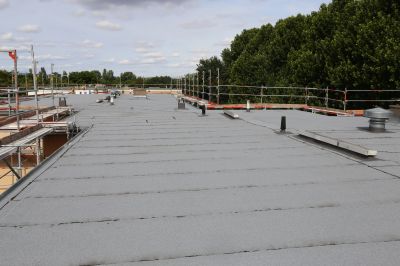Top Commercial Roofing Supplies for Enhanced Building Protection
Find the most trusted products that provide superior protection and durability for commercial roofing applications.
 Commercial roofing products encompass a broad range of materials and systems designed to provide durable, reliable, and weather-resistant coverings for large-scale commercial buildings. These products are essential for protecting structural integrity, maintaining energy efficiency, and ensuring safety for occupants. The selection of appropriate roofing materials depends on factors such as building design, location, and intended lifespan. Various types of roofing systems are available, each with unique characteristics suited to specific applications.
Commercial roofing products encompass a broad range of materials and systems designed to provide durable, reliable, and weather-resistant coverings for large-scale commercial buildings. These products are essential for protecting structural integrity, maintaining energy efficiency, and ensuring safety for occupants. The selection of appropriate roofing materials depends on factors such as building design, location, and intended lifespan. Various types of roofing systems are available, each with unique characteristics suited to specific applications.
Top Overall Option
Commercial Roofing Membrane System
A versatile and durable membrane system designed for large-scale commercial roofs, offering seamless coverage and ease of installation. It provides reliable weather resistance and flexibility for various building types, making it a popular choice among roofing professionals.
Types of Products For Commercial Roofings
Single-Ply Membranes
Thin, flexible sheets made from materials like TPO, PVC, or EPDM, suitable for various commercial roofing applications.
Built-Up Roofing (BUR) Systems
Multi-layered roofing systems composed of bitumen and reinforcing fabrics, providing long-lasting protection.
Modified Bitumen Sheets
Asphalt-based sheets that are modified for enhanced elasticity and durability, ideal for flat roofs.
Metal Roofing Panels
Durable metal sheets available in various profiles, offering longevity and low maintenance.
Spray-On Roofing Coatings
Liquid coatings applied directly to existing roofs to provide waterproofing and reflective properties.
Roof Insulation Boards
Insulation materials designed to improve energy efficiency and thermal performance.
Green Roof Systems
Vegetative layers installed on rooftops to provide additional insulation and aesthetic appeal.
Polyurethane Foam Roofing
Sprayed foam that creates a seamless, insulating, waterproof layer on the roof surface.
Thermoplastic Roofing Sheets
Flexible sheets made from thermoplastic polymers, suitable for a variety of commercial applications.
Waterproofing Membranes
Specialized membranes designed to prevent water infiltration in critical areas.
Roof Coatings
Protective coatings that extend the life of existing roofing materials and improve reflectivity.
Standing Seam Metal Panels
Interlocking metal panels with raised seams, offering a sleek appearance and weather resistance.
Roof Drainage Systems
Components such as gutters and scuppers designed to effectively channel water away from the roof.
Roof Edge Flashing
Metal or membrane components that seal roof edges and prevent water intrusion.
Popular Choices
Widely used for their flexibility and ease of installation, suitable for various commercial roofs.
Traditional multi-layered systems favored for their robustness and proven performance.
Popular for their durability, longevity, and low maintenance requirements.
Commonly applied to extend the lifespan of existing roofs and improve reflectivity.
Chosen for seamless insulation and waterproofing capabilities.
Valued for their flexibility and resistance to chemicals and UV exposure.
Essential for protecting critical roof areas from water damage.
Key for effective water runoff management on flat roofs.
Preferred for their sleek appearance and weather-tight design.
Critical for sealing roof perimeters and preventing leaks.
Commonly used to enhance thermal performance and energy efficiency.
Popular for their durability and suitability for flat roofing surfaces.
Favored for quick application and waterproofing properties.
Understanding the different product options can help building managers and contractors make informed decisions. From membrane systems that offer seamless coverage to mechanically fastened options that provide quick installation, the diversity of products ensures that there is a suitable solution for nearly every commercial project. Proper installation and maintenance of these products are vital to maximize their performance and longevity.
Commercial roofing materials are often engineered to withstand heavy foot traffic, exposure to harsh weather conditions, and structural movement. They may include options like single-ply membranes, built-up roofing systems, metal roofing, and modified bitumen sheets. Each type offers distinct advantages, such as ease of repair, flexibility, or fire resistance. Selecting the right product involves considering factors like cost, durability, and compatibility with existing building systems.
Investing in quality roofing products can contribute to the overall safety and functionality of commercial properties. Regular inspections, timely repairs, and appropriate product choices are key to maintaining roof integrity over time. Consulting with roofing professionals and understanding product specifications can help ensure that the selected materials meet the specific needs of the building and its environment.
Key Buying Considerations
- Compatibility with existing roofing structure and materials
- Weather resistance and durability in your climate zone
- Ease of installation and maintenance requirements
- Expected lifespan and warranty options
- Thermal insulation properties to improve energy efficiency
- Reflectivity and heat management capabilities
- Fire resistance ratings and safety standards
- Cost and overall value over the lifespan of the roof
- Compatibility with building design and aesthetic preferences
- Availability of professional installation services
- Resistance to foot traffic and mechanical stress
- Waterproofing effectiveness and sealing capabilities
- Flexibility for future modifications or repairs
- Environmental conditions such as wind uplift and snow load
- Local building codes and regulations compliance
